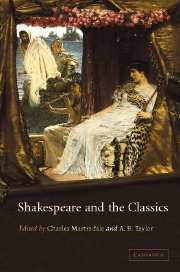Book contents
- Frontmatter
- Contents
- Notes on contributors
- List of abbreviations
- Introduction
- PART I AN INITIAL PERSPECTIVE
- PART II ‘SMALL LATINE’
- 2 Petruchio is ‘Kated’: The Taming of the Shrew and Ovid
- 3 Ovid's myths and the unsmooth course of love in A Midsummer Night's Dream
- 4 Shakespeare's learned heroines in Ovid's schoolroom
- 5 Shakespeare and Virgil
- 6 Shakespeare's reception of Plautus reconsidered
- 7 Shakespeare, Plautus, and the discovery of New Comic space
- 8 ‘Confusion now hath made his masterpiece’: Senecan resonances in Macbeth
- 9 ‘These are the only men’: Seneca and monopoly in Hamlet 2.2
- PART III ‘LESSE GREEK’
- PART IV THE RECEPTION OF SHAKESPEARE'S CLASSICISM
- Select bibliography (compiled by Joanna Paul)
- Index
8 - ‘Confusion now hath made his masterpiece’: Senecan resonances in Macbeth
Published online by Cambridge University Press: 22 September 2009
- Frontmatter
- Contents
- Notes on contributors
- List of abbreviations
- Introduction
- PART I AN INITIAL PERSPECTIVE
- PART II ‘SMALL LATINE’
- 2 Petruchio is ‘Kated’: The Taming of the Shrew and Ovid
- 3 Ovid's myths and the unsmooth course of love in A Midsummer Night's Dream
- 4 Shakespeare's learned heroines in Ovid's schoolroom
- 5 Shakespeare and Virgil
- 6 Shakespeare's reception of Plautus reconsidered
- 7 Shakespeare, Plautus, and the discovery of New Comic space
- 8 ‘Confusion now hath made his masterpiece’: Senecan resonances in Macbeth
- 9 ‘These are the only men’: Seneca and monopoly in Hamlet 2.2
- PART III ‘LESSE GREEK’
- PART IV THE RECEPTION OF SHAKESPEARE'S CLASSICISM
- Select bibliography (compiled by Joanna Paul)
- Index
Summary
‘We … have no indication that Shakespeare read Seneca's plays in the original. Nor do I find any evidence worth repeating that Shakespeare had read English Seneca,’ Baldwin wrote sceptically in 1944. Not everyone agreed. John W. Cunliffe, Jakob Engel, Cornell M. Dowlin, and Kenneth Muir collated parallel phrases which suggest that Macbeth teems with echoes from Seneca's plays – whether from the Latin original or Elizabethan translations. Conversely, when Frank Justus Miller translated dubio consilio (Agamemnon 50) as ‘doubtful of purpose’, echoing ‘infirm of purpose’, peractum est (Agamemnon 901) as ‘the deed is done’, perhaps remembering ‘I have done the deed’, or Infandos procul / averte sensus (Hercules Furens 973–4) as ‘Have done with these horrible imaginings’, inspired by Macbeth's ‘Present fears / Are less than horrible imaginings’ (1.3.136–7), he was rediscovering Seneca in the light of Shakespeare. This cross-fertilisation may not be merely rhetorical. It reflects similitudes of a deeper kind that reach well beyond formal echoes. The purpose of this chapter is not to assess any direct, clearly provable influence, although Kenneth Muir's theory that Shakespeare reread Seneca while working on Macbeth is not only tempting but plausible, and might account for the diffuse nature of Senecan features in the play. Analogies in thought, phrase, or situation become meaningful when considered not in isolation, but as elements of shared imaginative structures.
- Type
- Chapter
- Information
- Shakespeare and the Classics , pp. 139 - 155Publisher: Cambridge University PressPrint publication year: 2004

